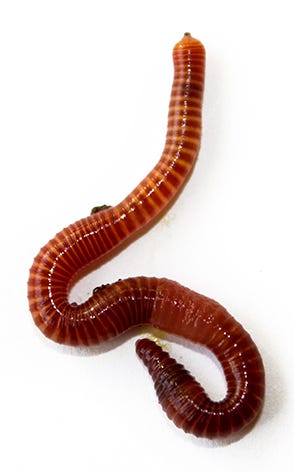Maximizing the Conveniences of Red Wiggler Worms: A Comprehensive Handbook for Home Gardeners and Urban Farmers
In the world of sustainable horticulture techniques, red wiggler worms stand as unsung heroes, quietly changing natural waste into nutrient-rich spreadings that can work wonders for soil health and wellness. By discovering the complexities of how to properly care for and make the most of the advantages of red wiggler worms, people can open a riches of possibilities for improving the sustainability and efficiency of their horticulture ventures.
Comprehending Red Wiggler Worms
Red Wiggler worms, renowned for their efficient composting abilities, are a types of earthworms widely used in vermiculture techniques. These worms, medically known as Eisenia fetida, flourish in decaying natural material, making them perfect candidates for composting.
One secret characteristic of Red Wiggler worms is their reproductive price. These hermaphroditic creatures possess both women and male reproductive body organs, enabling them to reproduce quickly under desirable conditions. A mature Red Wiggler can create several offspring in a short period, making sure a steady populace within a composting system.

Establishing Up a Worm Container
When developing a worm bin for vermiculture functions, appropriate preparation and interest to information are important for developing a favorable environment for Red Wiggler worms. Begin by picking an appropriate container for your worm bin.

Place the worm bin in an awesome, dark area far from straight sunlight and severe temperatures. On a regular basis monitor the wetness degrees, including water if the bedding feels flaky or completely dry. Feed the worms a well balanced diet of fruit and vegetable scraps, staying clear of citrus fruits, onions, and spicy foods. By following these actions, you can establish up a growing worm container that will efficiently process organic waste right into nutrient-rich vermicompost for your yard.
Feeding and Preserving Worms
Guaranteeing a healthy and well balanced diet is essential for the wellness and performance of Red Wiggler worms in a vermiculture system. It is crucial to stay clear of feeding them citrus fruits, onions, garlic, milk products, meat, and oily foods as these can be harmful to the worms or create undesirable odors in the bin.
Correct dampness levels are likewise important for the well-being of Red Wiggler worms. By carefully checking their diet plan, moisture, and environmental problems, home gardeners and city farmers can sustain a productive and healthy and balanced Red Wiggler worm population for composting functions.
Harvesting Worm Castings
To effectively extract nutrient-rich worm spreadings from the vermicompost, a methodical harvesting process is vital for making best use of the composting advantages. Red Wiggler Worms. The primary step in harvesting worm castings is to urge the worms to migrate to one side of the bin. This can be achieved by positioning fresh food scraps on one side and leaving the various other side uninterrupted for a few days. Once most of worms have actually moved to the side with fresh food, the castings can be accumulated from the contrary side.
After the castings have been collected, it is very important to separate any remaining worms from the castings to prevent hurting them during storage space or application. One effective technique is to create cone-shaped stacks of castings under bright light. Worms will naturally relocate away from the light, permitting for next easy separation and elimination.
Finally, the collected worm spreadings should be saved in a trendy, dark, and completely dry place to maintain their quality and performance as a nutrient-rich dirt modification. By adhering to these actions, home garden enthusiasts and city farmers can make the most of the benefits of red wiggler worms in their vermicomposting systems.
Utilizing Worm Castings in Gardening
The unification of nutrient-rich worm castings into click over here garden dirt can considerably enhance plant growth and total soil health and wellness. Worm castings, additionally referred to as vermicast, are a natural fertilizer produced by red wiggler worms as they break down organic issue. These spreadings are rich in necessary nutrients like nitrogen, phosphorus, potassium, and valuable microbes that advertise plant growth and enhance dirt framework.
When utilizing worm castings in gardening, it is necessary to blend them thoroughly right into the dirt or use them as a top clothing around plants. The slow-release nature of worm spreadings guarantees a constant supply of nutrients to plants gradually, lowering the danger of nutrient leaching and advertising long-lasting dirt fertility. Additionally, worm castings assist boost soil oygenation, water retention, and microbial task, developing a healthy atmosphere for plant origins to prosper.

Verdict
In final thought, the application of red wiggler worms in home horticulture and urban farming can dramatically profit soil health and plant growth. By understanding how to establish up and keep a worm bin, feed the worms effectively, and harvest their nutrient-rich castings, gardeners can make the most of the benefits of these earthworms.
In the world of sustainable gardening techniques, red wiggler worms stand as unhonored heroes, quietly transforming natural waste into nutrient-rich spreadings that can function wonders for soil wellness.When developing a worm special info bin for vermiculture objectives, appropriate preparation and interest to detail are vital for developing a conducive setting for Red Wiggler worms. The initial step in gathering worm spreadings is to motivate the worms to move to one side of the container. Worm castings, also recognized as vermicast, are a natural plant food produced by red wiggler worms as they break down organic matter. By recognizing how to establish up and keep a worm bin, feed the worms properly, and gather their nutrient-rich castings, garden enthusiasts can take full advantage of the advantages of these earthworms.